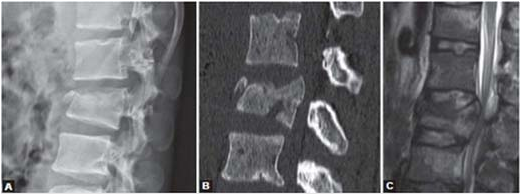Spine Fracture Stabilization
- Home
- Spine Fracture Stabilization
Spine Fracture Stabilization
How are thoracolumbar spine fractures caused?
Spine fractures can be caused by a variety of mechanisms. Common causes of spine fractures are
- Road traffic accidents
- Fall from a height
- sports accidents

The entire spectrum of spinal fractures from the simple to the most complex
The spinal cord may also be injured, depending on the severity of the fracture. Spine fractures require high energy trauma and associated injuries are the rule rather than the exception. Spine fractures, however, can also occur due to minimal trauma in the elderly when the bones are weakened by osteoporosis or other conditions like tumor or infection.
How are thoracolumbar spine fractures treated?
Treatment goals in thoracolumbar spine injuries include
- Protecting spinal cord function.
- Restoring alignment and stability of the spine.
- Allowing the patient to return to pre-injury activity at the earliest.
The doctor will determine the best treatment method based upon the type of fracture and other factors. In certain fractures, early surgery may be the treatment of choice especially in fractures which are unstable or associated with spinal cord or nerve injury.
What will be done during surgery for spinal injuries?
Surgery realigns the spinal column and holds it together using metal plates and screws (internal fixation) and/or spinal fusion. This serves many purposes, chief among these being
- Relief of pressure on the nerves and the spinal cord making it conducive for early neurological recovery.

Pressure on the spinal cord due to fracture fragments causes neurological deficit
- Stability of the fractured spine to decrease pain on movement and allow the patient to sit and stand as early as possible.

Unstable fracture treated by spinal stabilisation surgery
Can spine fractures be treated without surgery?
Some low-energy thoracolumbar fractures can be treated with a short period of rest followed by mobilisation in a brace or corset. Admission may still be required to tide over the acute pain and to investigate whether there are any underlying disease processes. Otherwise spinal injuries of the following types will require surgery,
- Neurological deficit
- More than two column injury
- Potential instability
- Spinal cord compression due to bone and epidural hematoma

Spinal cord impingement due to retropulsed bone fragments
What is the treatment for paralysis due to spinal cord injury?
Paralysis is one of the extremely disabling complications of cervical spine trauma. The cord injury may be complete or incomplete and surgery forms only the first part of the treatment. Further treatment includes specialised physiotherapy and nursing with adequate patient education by trained personnel. There are multiple complications associated with paralysis if the patient is inadequately monitored and treated. These include bedsores, urinary infection and lung infection. Patients with permanent paralysis also require rehabilitative support to get back to a near normal life.
Our hospital specialises in treating all types of thoracolumbar spine fractures and has scientifically proven protocols to decide whether surgery is required or not. We are also equipped with the latest equipment including intra-operative fluoroscopy and computer navigation to make spinal trauma surgery safe, effective and efficient. Our rehabilitation team also provides support and rehabilitation for the paralysed patients to make it back on the road to recovery.
Congenital Anomalies of the Spinal Cord

MRI image showing, Arnold chiari malformation with syringomyelia.
Congenital anomalies refer to aberrations of normal intra-uterine development of the spinal cord. There are different types and the symptoms, signs and need for treatment differs depending on the type of anomaly.
The commonly encountered anomalies are:
- Tethered cord syndrome.
- Diastematomyelia.
- Myelomeningocoele.
- Arnold Chiari malformations.
Most anomalies are obvious at birth due to swelling in the low back region or other neurocutaneous markers such as tuft of hair, skin appendages, birth moles etc. MRI is the investigation of choice for imaging spinal malformations. Plain radiographs are often very helpful to evaluate the bony structures of the spine. Spina bifida occulta is a common finding that may be seen with many different types of congenital malformations, but it is not specific in predicting congenital abnormalities. CT can be helpful to delineate bone abnormalities, identify bony or cartilaginous septa, and identify fat within the spinal canal.
All the problems can be treated effectively by surgical treatment. Surgery needs to be done at the earliest even in new born children to prevent neurological deficits.
Surgical Expertise
Testimonials
What Our Patients Say
EXCELLENT rating
Based on 107 reviews My father had rotator cuff problems and needed follow-up care.Dr.Ankith N V was exceptional. They provided thorough, compassionate care and clear communication. The clinic was well-equipped, and attentive Highly recommend.
My father had rotator cuff problems and needed follow-up care.Dr.Ankith N V was exceptional. They provided thorough, compassionate care and clear communication. The clinic was well-equipped, and attentive Highly recommend. RAVINDRA KUMAR2024-06-09Very good Orthopaedic Clinic and Dr Ankith sir well experienced Dr and also clear all the doubts for patients and their families...
RAVINDRA KUMAR2024-06-09Very good Orthopaedic Clinic and Dr Ankith sir well experienced Dr and also clear all the doubts for patients and their families... Dilip Gowda BR2024-05-29I had an outstanding experience with Dr. Ankit at Ankit’s Orthopedic . Dr. Ankit’s exceptional friendliness and professionalism made me feel comfortable and well-cared for throughout my visit. I highly recommend Dr. Ankit for their exemplary patient care and welcoming demeanor.
Dilip Gowda BR2024-05-29I had an outstanding experience with Dr. Ankit at Ankit’s Orthopedic . Dr. Ankit’s exceptional friendliness and professionalism made me feel comfortable and well-cared for throughout my visit. I highly recommend Dr. Ankit for their exemplary patient care and welcoming demeanor. Nikhil L2024-05-29Doctor is so knowledgeable and humble. Also he listens to us keenly and understands the problem. Highly recommended.
Nikhil L2024-05-29Doctor is so knowledgeable and humble. Also he listens to us keenly and understands the problem. Highly recommended. Akshay2024-05-29Good communicate with patients and cooperation well good, we are satisfied your treatment.
Akshay2024-05-29Good communicate with patients and cooperation well good, we are satisfied your treatment. renuka Mallikarjuna2024-05-22Best orthopaedic clinic in vijayanagar good service
renuka Mallikarjuna2024-05-22Best orthopaedic clinic in vijayanagar good service ಬಳ್ಳಾರಿ ನಾಗ2024-05-22Very good doctor and
ಬಳ್ಳಾರಿ ನಾಗ2024-05-22Very good doctor and Kiran S2024-05-18Really...this clinic is too good i recommended Dr.Ankith sir ..and doctor treat very well, he had more knowledge and as well as good human being and his staff is wonderful, this is the perfect place for orthopedic and spine
Kiran S2024-05-18Really...this clinic is too good i recommended Dr.Ankith sir ..and doctor treat very well, he had more knowledge and as well as good human being and his staff is wonderful, this is the perfect place for orthopedic and spine ashoka vc2024-05-17Good service well qualified doctor
ashoka vc2024-05-17Good service well qualified doctor srinath v2024-05-17
srinath v2024-05-17
Book Your Appointment Today!
Call us at 099644 83761 to schedule your visit. Your path to recovery begins at Dr. Ankith’s Orthopedic & Spine Care Clinic. We look forward to helping you achieve your health goals!
